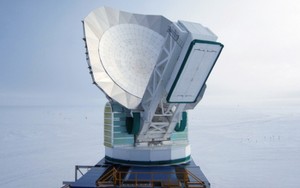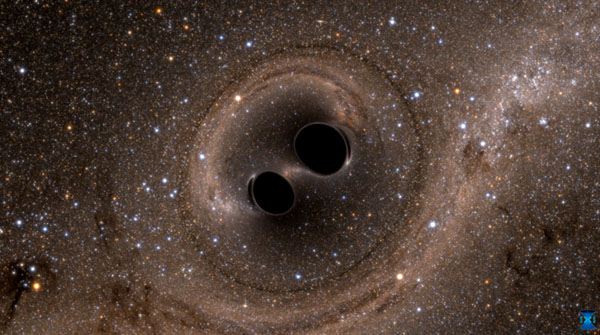
Credit: John Mallon III, National Science Foundation
Astronomers building a globe-spanning virtual telescope capable of photographing the “event horizon” of the black hole at the center of our Milky Way have extended their instrument to incorporate the South Pole Telescope (SPT), a 280-ton radio telescope located at the National Science Foundation’s (NSF) Amundsen-Scott South Pole Station in Antarctica.
Dan Marrone, an assistant professor in the University of Arizona’s Department of Astronomy and Steward Observatory, and several colleagues flew to the Pole in December to incorporate the SPT into the largest virtual telescope ever built–the Event Horizon Telescope, or EHT. By combining telescopes across the Earth, the EHT will take the first detailed pictures of black holes.
The SPT is the latest addition to the EHT, an array of telescopes spread out across the globe and linked using a technique known as Very Long Baseline Interferometry, or VLBI. Larger telescopes can make sharper observations, and interferometry allows multiple telescopes to act like a single telescope as large as the separation–or “baseline”–between them.
“Now that we’ve done VLBI with the SPT, the Event Horizon Telescope really does span the whole earth, from the Submillimeter Telescope on Mount Graham in Arizona, to California, Hawaii, Chile, Mexico and the South Pole,” Marrone said. “The baselines to SPT give us two to three times more resolution than our past arrays, which is absolutely crucial to the goals of the EHT. To verify the existence of an event horizon, the ‘edge’ of a black hole, and more generally to test Einstein’s theory of general relativity, we need a very detailed picture of a black hole. With the full EHT, we should be able to do this.”
The prime EHT target is the Milky Way’s black hole, known as Sagittarius A* (pronounced ‘A-star’). Even though it is 4 million times more massive than the sun, it is tiny to the eyes of astronomers. Because it is smaller than Mercury’s orbit around the sun, yet almost 26,000 light years away, studying its event horizon in detail is equivalent to standing in California and reading the date on a penny in New York.
With its unprecedented resolution, more than 1,000 times better than the Hubble Telescope, the EHT will see swirling gas on its final plunge over the event horizon, never to regain contact with the rest of the universe. If the theory of general relativity is correct, the black hole itself will be invisible because not even light can escape its immense gravity.
First postulated by Einstein’s general theory of relativity, the existence of black holes has since been supported by decades’ worth of astronomical observations. Most, if not all, galaxies are now believed to harbor a supermassive black hole at their center, and smaller ones formed from dying stars should be scattered among their stars. The Milky Way is known to be home to about 25 smallish black holes ranging from five to 10 times the sun’s mass. But never has it been possible to directly observe and image one of these cosmic oddities.
Standing 75 feet tall, the SPT sits at an elevation of 9,300 feet on the polar plateau at Amundsen-Scott, which is located at the geographic South Pole. SPT was built by the University of Chicago with funding and logistical support from NSF’s Division of Polar Programs. Polar manages the U.S. Antarctic Program (USAP), which coordinates all U.S. research on the southernmost continent.
Polar supports the SPT through an award to John Carlstrom, of the University of Chicago. The EHT work was funded through collaborative NSF awards made by the Division of Astronomical Sciences in NSF’s Directorate for Mathematical and Physical Sciences to Marrone, Sheperd Doeleman at MIT’s Haystack Observatory and to Carlstrom. Installation of the EHT sensor on the telescope was facilitated by the USAP.
The 10-meter SPT operates at millimeter wavelengths to make high-resolution images of Cosmic Microwave Background (CMB) radiation, the light left over from the big bang. Because of its location at the earth’s axis and at high elevation where the polar air is largely free of water vapor, it can conduct long-term observations to explore some of the biggest questions in cosmology, such as the nature of dark energy and the process of inflation that is believed to have stretched the universe exponentially in a tiny fraction of the first second after the Big Bang.
“We are thrilled that the SPT is part of the EHT. The science, which addresses fundamental questions of space and time, is as exciting to us as peering back to the beginning of the universe,” said Carlstrom.
Pages: 1 2






